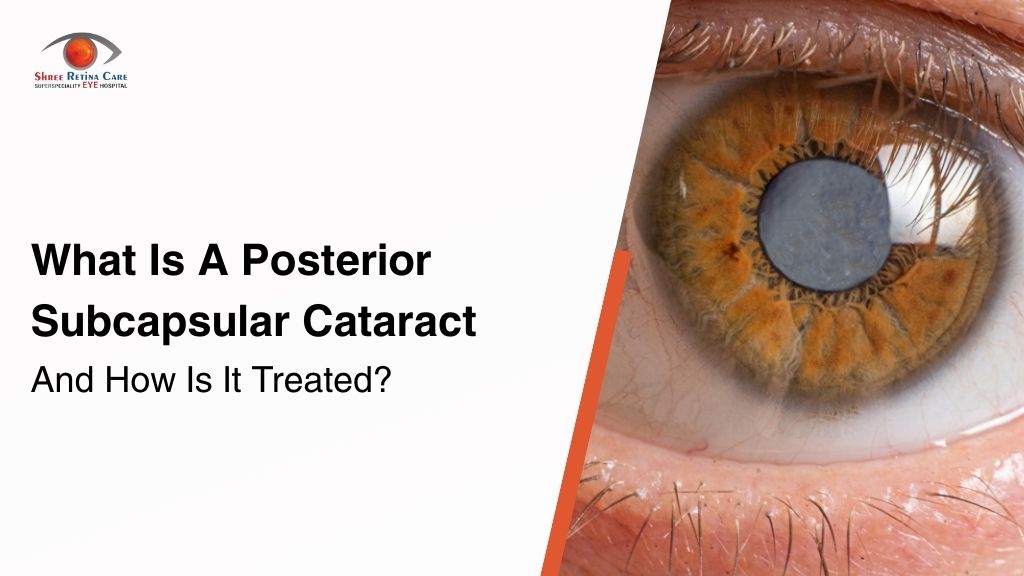What Is A Posterior Subcapsular Cataract, And How Is It Treated?
When vision starts getting blurry or your eyes start struggling for reading under bright light conditions, it might not just be about aging eyes. One common reason behind such issues is a condition called posterior subcapsular cataract (PSC).
This blog explores everything you need to know about it, from causes and symptoms to diagnosis and treatment options.
Posterior Subcapsular Cataract: Meaning
The light passage that goes through the natural lens of the eyes to the retina goes well until the lens remains in good condition. But with time, the lens becomes cloudy, causing what we call a cataract.
cataracts are of many types, and one of them is the posterior subcapsular cataract.
In Posterior Subcapsular Cataract (PSC), the lens gets affected from the back side of the eye , right in front of the thin lens capsule. Since this area is exactly where light enters the eye, even a small patch of clouding can make it hard to see clearly.
Key Symptoms To Watch For
People with PSC may notice symptoms earlier compared to other types of cataracts. Common signs include
- Blurry vision, mostly noticed in bright light
- Trouble reading small text
- Too much glare from headlights while driving at night
- Difficulty seeing in sunlight
- Halos around lights
Since the affected area lies near the central line of sight, PSC often impacts daily tasks such as reading or driving.
What Causes PSC?
Posterior subcapsular cataracts can form due to several factors:
- Aging: Like other types of cataracts, PSC is more likely to occur growing age.
- Long-term use of steroid medications: Both oral and eye-drop forms can increase the chances of increasing risk.
- Diabetes: High blood sugar levels may affect the clarity of the eye’s lens.
- Radiation exposure: Including from cancer treatments.
- Eye trauma or previous eye surgery
Sometimes, PSC can also appear in younger individuals due to medication or health conditions.
Diagnosis And Eye Exams
If your vision doesn’t feel bright, the first thing to do is visit an eye doctor. During the diagnosis, they may use a few easy ways to find out the root cause:
- Visual acuity test: It includes checking how well the letters are readable from a distance.
- Slit-lamp examination: In this, the front and the back part of the eyes are checked through a special microscope.
- Dilated eye exam: This is to check the condition of the back side of the lens through the eye drops, as the eye drops widen the pupil, which enables seeing the condition in detail.
These tests help determine the type, size, and location of the cataract.
Treatment Options
In the initial stages, changing the glasses or adding anti-glare coatings supports clear vision quality.
However, since PSC often progresses faster than other types of cataracts, people end up choosing the surgical options if they are a little late in consulting a doctor.
Cataract Surgery
- The cloudy lens is removed through an advanced technique called phacoemulsification, where ultrasonic waves break the natural lens.
- A new artificial lens, called an intraocular lens (IOL), is placed in the same location.
- The procedure usually takes less than 30 minutes and is done on an outpatient basis.
Most people recover quickly and experience a major improvement in vision within a few days.
How PSC Differs From Other Cataract Types
It helps to understand how PSC compares to other cataracts:
| Type | Location of Clouding | Speed of Progression | Common Symptoms |
| Posterior Subcapsular | Back of the lens | Faster | Glare, trouble in bright light |
| Nuclear | Center of the lens | Slow | Gradual vision loss, near-sightedness |
| Cortical | Edge of the lens | Moderate | Light scatter, reduced contrast |
Because PSC lies directly in the visual path, even small changes can affect sight more than other cataracts.
Can It Be Prevented?
Once the PSC is diagnosed, prevention depends upon the severity of the condition in all cases, but some steps can lower the risk.
- Manage diabetes and blood sugar levels
- Use steroid medications only under medical supervision
- Wear sunglasses to protect from UV light
- Eat a healthy diet rich in antioxidants
- Have regular eye checkups, especially after age 40
Early detection helps in planning treatment before vision gets worse.
When Should You See A Doctor?
There are some common signs shared with you that can help you know whether you are having PSC or not. Although the surety can only be given by an eye specialist, at least you can protect yourself by early consultation. If you notice any of the following signs, it’s time to book an eye exam:
- Sudden or ongoing blurry vision
- Trouble seeing in bright light
- Night driving becomes harder
- Need for frequent changes in eyeglass prescription
Timely evaluation can help prevent complications and ensure the right care at the right time.
Conclusion
A posterior subcapsular cataract may sound complicated, but it’s a common and treatable condition. Knowing the symptoms and understanding the root cause can help you to take early action.
If vision problems are affecting your daily life, don’t wait. A visit to an eye specialist can help bring things back into focus.

